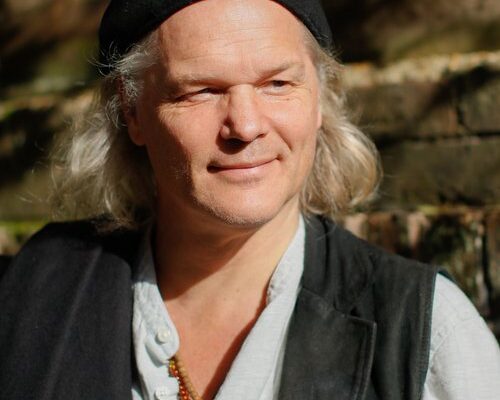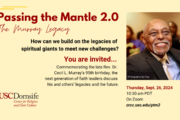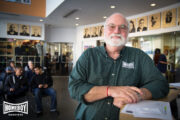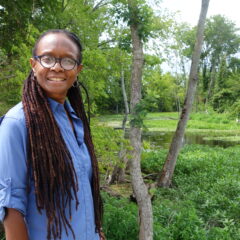This article was originally published on Religion Unplugged with the support of CRCC’s global project on engaged spirituality.
BRIGHTON, England — According to Norse mythology, the world is an immense tree. Known as Yggdrasil, this eternal tree stands at the center of the cosmos, and is the source of all life, all things. From Yggdrasil’s acorns sprouted Ask, the first man, born of an ash tree, and Embla, the first woman, made of an elm.
“And the gods formed man and woman in their own image of two trees, and breathed into them the breath of life,” goes the Prose Edda, the 13th century source book of Norse myths.
Ironically, today, both the ash and the elm are suffering, plagued with disease and critically endangered.
That humanity’s original ancestors are under threat is a potent metaphor for Andreas Kornevall, a Swedish-British ecologist and educator who is devoted to bringing the wisdom of Old Norse myths and rituals to bear on contemporary life — particularly in relation to current environmental crises. Through storytelling, scholarship and ceremonies, Kornevall excavates the ecological ethic inherent in the pre-Christian spirituality of northern Europe, in which — like so many ancient practices around the world — the Earth itself is the locus of the sacred, and the gods are embodiments of natural phenomena.
I met Kornevall, 52, near his home in Brighton, England, where we spent an afternoon sitting in the tree-shaded courtyard of a church turned art gallery. Blond and quietly charismatic, with a manner somewhere between passionate professor and carefree surfer, he described how his work reviving the old customs is an effort to refresh how we comprehend our increasingly precarious place on Earth — and, indeed, restore an innate, age-old sense of interconnection with and reverence for the natural world.
Within moments of meeting, he pointed out to me that the words “tree” and “truth” derive from the same Old English root — a synchrony that speaks to what we’ve long known but of late have forgotten. As he writes in his book, “Waking the Dragons: Norse Myth, Runes, and Magic”:
“The eternal tree is vulnerable to our forgetfulness. Forgetfulness causes drought and wildfires and empties the well that feeds the tree. Too much forgetting is an ecological disaster.”
The seeds of Kornevall’s three decades of work at the intersection of spirituality, environmentalism and activism were first sowed in childhood.
A path to Old Norse paganism
Born in Sweden, Kornevall spent his early years in Chile, where his father worked for the U.N.’s International Labour Organization. Shortly after his family arrived in Santiago, General Augusto Pinochet seized power from the Allende government in the 1973 military coup. As the government targeted leftists and intellectuals, Kornevall remembers soldiers coming to his house and throwing his parents against the wall. Their Swedish passports — considered neutral —saved them. “I remember a feeling of hopelessness and fear in the face of tyranny,” he recalls. As a young child, he was left with a skepticism toward authorities and governments and a sensitivity to the ways in which power often hardens around hate rather than human thriving.
During the same period, Kornevall had what he describes as his first truly spiritual experience. As he and his family were driving from Santiago up into the Andes, he remembers seeing a face in a mountain.
“The mountain had become an anthropomorphic being,” he remembers. “I thought, that mountain is thinking; it has opinions; maybe it can talk to me. It filled me with a sensation that there is part of me which is not only human.”
Each time they drove past the mountain, Kornevall would continue this “animistic exchange,” developing an intuitive sense of nature’s ability to “speak” back to us, to communicate wisdom in its own voice, its own language — if we choose to listen.
Though that notion was somewhat at odds with the strict Lutheran backdrop of his upbringing, which favored order over mystery, strictness over whimsy, when Kornevall returned to the forests and lakes around Stockholm as an adolescent, he encountered similar animistic sensibilities in the old Swedish customs that are fixtures of everyday life.
“When you grow up there, you don’t even notice it,” he says. Midsummer, for example, involves worshipping the phallic deity Frey, god of fertility. “You dance around like frogs, for salmon to return, for crops to return to the fields.”
Working in nongovernmental organizations
Initially, Kornevall’s career was a patchwork expression of his interests: He worked with nongovernmental organizations and disaster relief efforts in India, started an organization that places volunteers abroad, and did a stint as a nature guide in Maine. Throughout this time, he describes himself as a seeker, exploring far-flung meditative and spiritual practices.
“I was always seeking something from far away — India, the Middle East,” he said. “If I had psychological or spiritual questions, I would look elsewhere, outside my own culture.”
That began to change, however, in the early 2000s, when Kornevall was living in the mountains of the French Pyrenees. In 2004, the last native Pyrenean brown bear, a female known as Canelle (French for “cinnamon”) was shot by a hunter. The news of the bear’s extinction, after having lived in those mountains for some 250,000 years, shocked Kornevall profoundly.
“I couldn’t reconcile this,” he says. “I thought, where is the church now? Where is the moral force to help us face what’s happened, to lay a wreath, to reflect? How do we say farewell to this amazing creature?”
Bereft and angry, Kornevall went looking for answers. He happened to open up his copy of the “Poetic Edda,” the collection of Old Norse verse thought to have originally been written on animal skins during the Viking age.
“Suddenly, right in front of me, there was an instruction from Hela, the goddess of death,” he says. “She said, ‘If you want to bring light back to the land, you have to learn to grieve deeply.’”
Kornevall took this direction to heart and set about devising his own way to meaningfully mourn this loss. He decided to build a “cairn” — a stack of stones that today often serves as a trail or summit marker but in prehistoric times was raised as memorials.
Gathering together his friends and neighbors, he asked each person to lay a stone for an extinct species. Slowly, as the names of various lost creatures were called out — the Yangtze river dolphin, the blue butterfly. The pile of stones grew, and the weight of loss transformed into a monument.
“We wept like little kids,” he says. “And I realized I had made some kind of peace with what had happened. Grief moved into a form of celebration.”
Expanding the life cairn
News of this memorial, which came to be called a life cairn, spread organically; today, Kornevall says, life cairns have sprung up around the world, from the Galapagos to Mauritius. And though Kornevall himself didn’t have prior experience leading spiritual ceremonies, the events in the Pyrenees set him on a new course. He began to look more deeply into Norse texts, finding applicable wisdom in myths like the Water of Life, a rite-of-passage journey into interior and exterior landscapes, or stories of how the warring sky gods and nature gods achieved reconciliation.
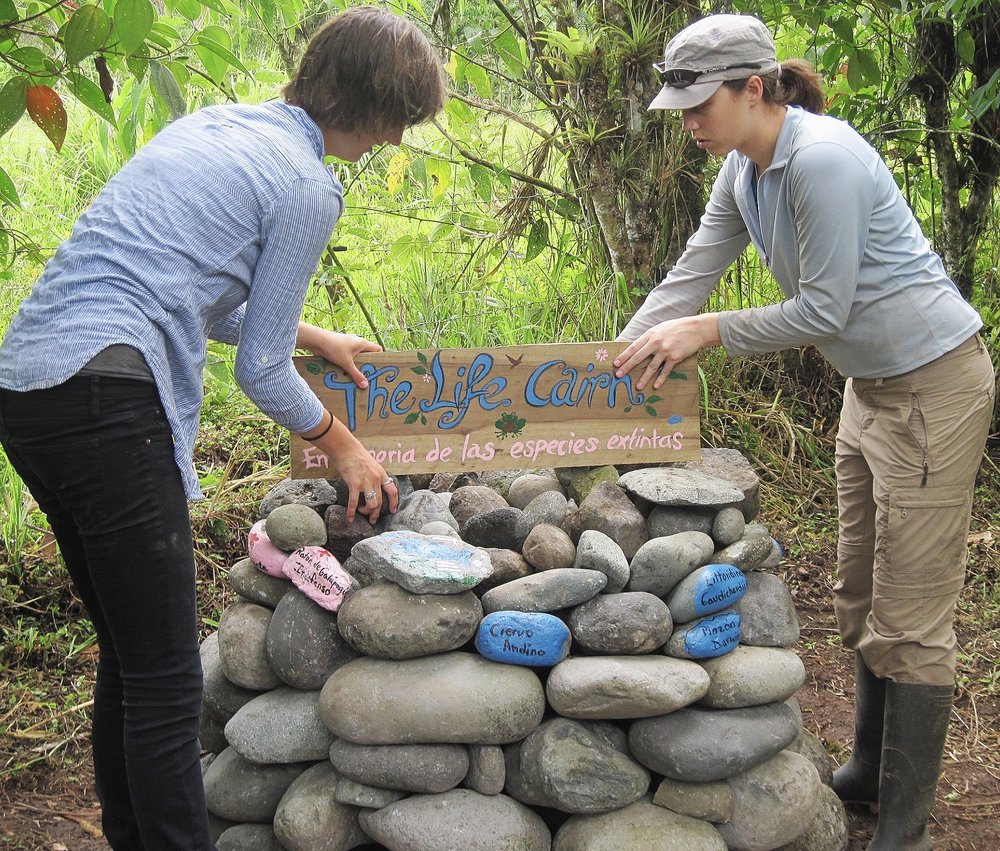

“The more I explored, doors and doors started to open up,” he says.
Soon thereafter, he moved to England, bringing with him a charity he had recently started called the Earth Restoration Service, which works with schools to plant trees and restore wild ecosystems.
“When I went into schools, the moment I started blabbing on about photosynthesis, there was very little interest,” he says. “I had to bring in something else.”
So Kornevall turned to his burgeoning knowledge of folklore and myth, trading science lessons for a drum and a tale.
“Suddenly, the trees are speaking, they have names, they have relationships with people” — ideas that he found helped kids connect more deeply with the environment, and cultivated an intuitive sense of why it should be preserved. “I became a storyteller out of necessity,” he says.
In reimagining himself as not just an ecologist but a carrier and translator of the myths of his own culture as well as customs in the local areas in which he was working, he had come upon a way to both further his environmental work and nurture his spiritual inclinations. From there, his worlds converged.
With the charity up and running — to date, the Earth Restoration Service has served some 750 schools across the U.K. and planted over 60,000 native trees — Kornevall shifted more deeply toward storytelling and ceremony, studying the art of oral storytelling at The School of Myth in Dartmoor, England, and joining Sweden’s Forn Sed association, a loose community of scholars working to unearth the region’s ancient and oft-forgotten traditions, legends and languages.
Today, he can be found lecturing on Norse myths, teaching workshops on runes (phonetic symbols often bestowed with oracular potential), performing stories (usually with a drum, a whistle, or a lyre) at festivals, or increasingly, leading ceremonies known as blóts (a form of worship that traditionally included sacrifice).
All of these forays — replete with river goddesses, talking sunbeams and mother cows closely connected to the sacred cows of the Hindu tradition — provide opportunities to acknowledge the land and life forms to which we are inseparably connected and to whom we owe our survival.
Inherent in these old customs and stories is “a relational thread … to the larger world around us,” Kornevall writes. He asks, “In today’s world, with which words or gestures of beauty can we say ‘thank you’ to those beings that have kept us fed and clothed for millennia?”
An ecological connection
Ancient ceremonies and myths that speak to a deep-rooted reverence for the Earth, Kornevall believes, offer templates to help us begin to answer that question — and, in turn, direct us toward a fundamental ecological sensibility that might ultimately be more activating than doomsday climate change reports.
Of course, this sensibility is by no means unique to Old Norse customs. Indeed, Earth worship is more likely to call to mind cultures beyond Europe; an ecological current runs deeply through Hinduism, Native American spiritual practices, Aboriginal traditions and Islam, among so many others. But Kornevall, given his heritage, is keen to explore the customs of his ancestors and remind the Christianized and increasingly secularized West of its own past.
From his base in the United Kingdom, a land strewn with stone circles where prehistoric peoples would worship the sun, he sees value in uncovering such traditions of closer to home.
“Many people here are so cut off from their ancestral past,” he says. “And then the soul suffers, the well of memory dries up. And when that dries up, there is an ecological disconnect. Amnesia creates ecological disaster because our relationship with the land is threadbare.”
The Global North’s outsized responsibility for carbon emissions might serve as evidence for that.
And Kornevall is not alone in his inclinations. In recent years, as awareness and angst about climate change and human impact on the planet has intensified, the U.K. has seen a significant rise in people exploring the ecological underpinnings of ancient regional customs and identifying as pagan or neopagan.
Iceland’s tradition of Old Norse paganism, Ásatrú, is enjoying a renaissance in an environmentally minded modern form; it is the country’s fastest growing religion. In Denmark, Valheim Hof, a temple dedicated to the Norse gods, recently opened — supposedly the first since the Christianization of Scandinavia in the Middle Ages.
Old Norse brutality
However, these activities aren’t without controversy. While Kornevall’s contemporary interest in this tradition has to do with its emphasis on ecological interconnectedness, as with every religion, the legacy of Old Norse customs isn’t spotless. Its historic adherents owned slaves, conducted human sacrifices and are often perceived the world over as militaristic and bloodthirsty.
“I’m not naive to think that Vikings were just nice fisherman who sat on hills and meditated,” says Kornevall. “But violent conflict has always had more to do with money and power and trade than religion. We all have that inheritance.”
Our task, says Kornevall, is to choose what to preserve and what to discard, and acknowledge rather than suppress the irreconcilable shadows of the past.
“A modern mindset can never understand what the ancients were thinking when they pursued human sacrifices,” he says. “That’s a part of history which I really don’t understand.”
Another painful issue is that elements of Old Norse heritage have long been co-opted by the far-right; in recent years, its symbols have been used by neo-Nazis and white supremacists, who link the tradition with a mythical golden age of northern European racial purity.
How does Kornevall deal with this?
“It’s horrible. It makes me want to cry. Because symbols carry so much energy, they’re susceptible. An extremist can just say ‘this represents marching to the White House’ or ‘this represents our superiority’ and turn it into something dangerous.”
Part of his work, then, involves countering this symbolic “theft” with stories that reveal truer meanings. Thor’s hammer — seen tattooed on a Jan. 6 insurrectionary — isn’t about glorifying violence but is rather a sacred symbol meant to evoke the thunder god’s mythical confrontation with giants in an effort to protect humankind.
“When I think of struggling against corporate giants, big banks — Thor’s current is there,” he says. “Others may try to co-opt symbol, but they haven’t succeeded.”
A blót ceremony
Rituals, symbols, and stories are never frozen in time, though, and even Kornevall’s efforts to revive the old customs inevitably involves revision, experimentation and imaginative leaps. I saw this in action when I attended a blót ceremony Kornevall hosted at the Clophill Center, a rural retreat space outside London.
On a blustery evening last autumn, I arrived at the sprawling grounds, dotted with yurts, wooden structures and animal heads; a few dozen people in baggie trousers and jewel-toned scarves were milling about in the quiet dusk.
As the sun disappeared, we moved into a dimly lit room and formed a 40-strong circle around an array of offerings set out on the floor: flowers, animal skins, fruits, rune stones, bottles of mead. The arrangement had the colorful flamboyance of a Hindu “puja” ritual — fitting, as the Norse tradition’s Indo-Aryan roots means this ceremony is directly connected to rituals performed along the Ganges.
Kornevall commenced the ceremony with the beating of a drum; soon, several people followed suit with their own drums. We stood in the quick, heavy drumbeats for a long time, the sound shaking our bodies.
Eventually, Andreas began to shout, “To all we have loved and all we have lost — we welcome you! “
Someone hollered: “Hail the gods!”
Another whooped back: “Hail the goddesses!“
More yelling, cheering, drumming, and then — silence. The air felt newly charged.
Andreas started passing around a drinking horn full of mead; each person was to touch the horn to their forehead, take a sip and speak, unbidden. Someone said the name of a recently departed friend; another invoked the crisis of male suicide. A woman in flowing fabrics recited the names of many female ancestors, all the way back to one who was killed for being a witch in Scotland in the 1500s. For several minutes, a young man mused poetically on climate change and war. Some people seemed genuinely able to access some internal, unconscious stream; others kept it brief. I, feeling out of place in my reporterly trenchcoat and beret, simply thanked everyone for allowing me to participate.
Then, the group began to sing a song to call in the Seeress — the incarnation of Mother Earth:
“Mother I feel you under my feet. Mother I feel your heartbeat.”
Eventually, an actual woman emerged from offstage, her face and body hidden by full-length robes, and took the high seat on a raised table. Someone whispered to me that this role is usually assumed by a post-menopausal woman who the blót guide chooses in advance; in pre-Christian Scandinavia, it would have been a village matriarch.
Participants began to call out questions to the Seeress:
“How should we care for the land? How should I help my son? When will the war end?”
After describing her journey to a heavenly place on the other side and back again, in an effort, it seemed, to authenticate her connection with the gods, the Seeress began answering the questions. Her tone, in this instance, was more grandmotherly than prophetic (How should we live better? “Stop farting around.”) though I was told that each Seeress brings her own personality to the performance.
It was slightly comical, this moment of theater — less enveloping than the drums and mead — though the sense of partaking in an ancient process was palpable. For that hour, we weren’t in the suburbs of London but in a kind of metaphorical deep north, somewhere long ago, surrounded by snow and skins and fire, pulling meaning from a primeval well.
This sense of time collapsing — of calling the past into the present — is precisely what Kornevall finds useful about ceremonies like this. They anchor us, he suggests, to the great continuum of humanity, with all its diverse and recurring patterns, practices, scripts.
And though Kornevall is working in a particular tradition, he emphasizes that it’s not the type of ritual, but ritual itself, that matters. He envisions what he calls an “ancient future,” one in which we turn once again to ceremonies and rituals — however old or new, however authentic or invented — to give shape and meaning to our presence on Earth and to help us contend with the inevitable, ongoing loss and change that our disconnect from the planet has wrought. “In the ancient future,” he hopes, “ceremonies will not be redundant, but indeed stronger.”
Eventually, the room ran out of questions, the Seeress took her robes off, Kornevall set down his drum and the lights came on. But as we looked around, grinning and nodding at each other as we readjusted to this reality, it was clear that some residue of wherever we had been, whoever we had encountered, whatever we had found, remained.
The horn of mead continued to circulate, and the candles burned themselves out. As a Hasidic saying goes, everything was the same but a little bit different.
Click here to read the full article on Religion Unplugged.
Meara Priyanka Sharma is a journalist fellow with the Spiritual Exemplars Project.
